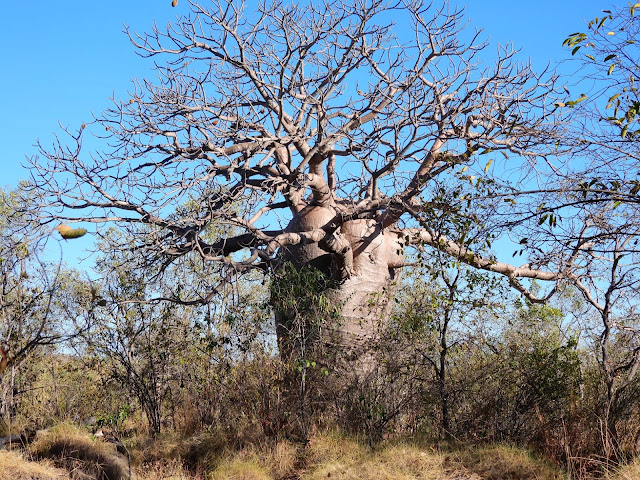Sunday, 18 July 2021
Every great show has its grand finale, and so does ours. Our final day of explorations, before we head south on the long 2400 km trip home, centres on the Devonian age and the ancient reef system that lined the Kimberley plateau, under water 350 million years ago. We start with our camp spot.
Dawn’s earliest light starts around 5am. It’s not long after that we roll out of bed, intent on exploring the creek bed that Johan found so fascinating last night. He wants to find the source of the stream he found trickling over the edge of some white-washed rock in the otherwise dry creek bed. The early morning light bleeds through the trees. Bird life is prodigious, in chorus and variety.
Not far up our rock-hopping escapade an unexpected wetlands appears. Pools of clear clean water encircled with dainty pink-flowering greenery. Ducks fly off at our arrival, startled. We follow the pools further upstream. Where does the water come from? I touch the water with my fingers and feel its warmth. A spring perhaps? We follow a dark shrub-enclosed channel up and up – until suddenly it stops and becomes a dry creek bed again. How strange! What’s going on?
Mystery unresolved, we watch and photograph birds, boab trees and the curious fossils embedded in this primeval reef system.
Tunnel Creek offers another peek into the mysterious depths of ancient water sources, half an hour up the road. Unlike our quiet, solitary morning, the carpark is full of bustling tourists, many of them half dressed. We quickly learn that visitors should expect to get wet if they want to fully experience the creek, so bathers or minimal dress is recommended.
The opening to the tunnel cave sits under a massive overture of craggy cliff. Twenty metres into the cave the world darkens and most of the visitors are wearing headlamps or carrying torches. Mums and dads are carrying noodles and other floating devices and I wonder why. Further in, I get it: the only way forward is to wade, then swim across a small deep pool to the far shore, where the quest continues. It’s a scary enterprise, made possible for the kids who are loaded onto their floating paraphernalia and coaxed across the dark pool. With no floaties, we wade in, then sink, then swim. The water is cool, our head torches light the way. The tunnel winds for another 600 or so metres before opening to daylight where we sit on the rocks to warm our chilled bodies before returning the way we came.
The experience is exhilarating, other-worldly. It’s something like a hard core, down-and-dirty version of a Disneyland ride: the one where you sit in a boat and go into deep dark places with “It’s a small world after all” playing cheerily in the background, eerie sights and new surprises around every corner. Stalactites fall like phantoms from above and enormous tree roots hang Tolkeinesque-like from the ceiling, tangled and winding across the floor until they reach the water. A gentle, warm waterfall trickles down the smooth sides of a lampshade-shaped stalactite made of a yellow wax-like substance that glows in the torchlight. Regrettably, because of the need for the swim, we can’t bring the camera to record much of what we see in the deep inner bowels of the cave.
The way in the tunnel echoes with people’s chatter and children’s squeals. But as we head back after our warm sun bath, we meet silence and darkness. It seems we’ve landed in the fortunate infrequent break in tunnel traffic. In the pitch black, we walk hand-in-hand, apprehensive as our meagre headlamps keep us from tripping on rocks and tree roots. For a sacred and scared ten minutes the cave is ours, quiet and desolate.
Windjana Gorge is our final destination, a canyon known for two things: it’s fossilised remains of the great Devonian creatures that lived in the reefs of that time and the prevalence of freshwater crocodiles. The canyon is lovely, but lacks the intensity of the Bungle gorges. Yet the gentle, relaxed setting is welcome and makes space for more subtle experience: the sight of lazy, lanquishing crocs floating on the still waters of the Lennard River; the search for marine shapes fossilised into the rambling canyon walls that line the trail up the river; watching a graceful white-faced heron, unconcerned with the cluster of crocs resting on the shoreline, deep dive like a snake underwater, searching for an afternoon meal; listening to the fresh lively birdsong echoing through the canyon walls; the sweet smell of buds at the top of a Jack-and-the-beanstalk type plant, popping open into pretty purple-and-white blossoms; meeting a shy black-faced wallaby sitting steadily on a rock, nibbling a dry leaf. A calm, restorative end to an event-filled day.
Fifty kms before the town of Derby we turn onto a dirt road with a sign that reads “May River, 12 kms”. May is a wide rocky riverbed, water flowing on its far edge. It’s here we find a welcome spot on the rocks to make our camp for the night.













omg most exotic pics yet. Is that a cartoon kingfisher?? I love this place!
ReplyDelete